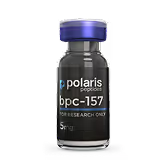Hexarelin
Hexarelin is a six–amino-acid peptide that stimulates the ghrelin receptor to trigger natural growth-hormone release. When injected, it boosts GH levels to support muscle repair and metabolism without significantly raising other hormones. It’s studied in research on growth-hormone health and tissue recovery.
Compound Overview
About the product
Hexarelin’s sequence is H-D-Ala-D-2-naphthylalanine-Ala-Trp-D-Phe-Lys-NH₂, with D-amino acids and a C-terminal amidation to resist enzymatic degradation. The D-2-naphthylalanine (D-2Nal) enhances receptor binding affinity and stability. It is synthesized by Fmoc solid-phase peptide synthesis and purified by HPLC to >95 % purity. Mass spectrometry confirms correct mass and sequence.
Hexarelin binds to ghrelin receptors on pituitary somatotrophs and hypothalamic neurons, directly triggering GH release and indirectly promoting GH–releasing hormone secretion. It does not significantly raise cortisol or prolactin levels in human subjects. The peptide increases both the amplitude and frequency of GH pulses. GH elevations occur within 30–60 minutes of subcutaneous administration.
Hexarelin benefits have been studied primarily in relation to its ability to increase natural GH and IGF-1 levels. In human trials, Hexarelin produced robust increases in serum GH and sustained IGF-1 elevations compared with baseline. Participants showed improvements in markers of protein metabolism and lean-body-mass maintenance. Research continues into its potential for muscle-wasting conditions and age-related GH decline.
Reported adverse events are mild and transient, most commonly flushing, transient hunger increase, and injection-site discomfort. No serious safety concerns or clinically significant laboratory abnormalities emerged in studies lasting up to several weeks. Appetite changes are generally well tolerated. Long-term safety data beyond these trial durations are not available.
Hexarelin is assembled via Fmoc solid-phase peptide synthesis on a resin support, incorporating D-amino acids and amidation. After chain assembly, it is cleaved and purified by preparative HPLC to research-grade purity. Mass spectrometry confirms sequence integrity and correct molecular weight. Production follows peptide-compounding standards.
Hexarelin is classified for research use only and is not approved by the U.S. FDA, EMA, or other major regulatory agencies. It cannot be prescribed or sold as a clinical treatment. Laboratories may obtain it under investigational peptide regulations, which vary by jurisdiction. No therapeutic or over-the-counter formulations exist.
Human studies have administered 100–200 µg subcutaneously twice daily, often spaced 30 minutes before meals. Some protocols explore up to 300 µg per dose without additional safety signals. No standardized dosing guidelines exist outside research settings. All administration should adhere to approved investigational protocols.
- Do use only under IRB-approved research protocols.
- Do monitor serum GH, IGF-1, and basic metabolic panels.
- Don’t combine with other GH secretagogues or exogenous GH without oversight.
- Don’t use during pregnancy, lactation, or active malignancy.
- Q: How quickly does GH rise?
- A: GH levels typically peak within 30–60 minutes after injection.
- Q: Does it stimulate appetite?
- A: It can cause mild, transient increases in hunger.
- Q: Are cortisol or prolactin affected?
- A: No significant changes in cortisol or prolactin have been observed.
For research use only. Not approved for medical use.


